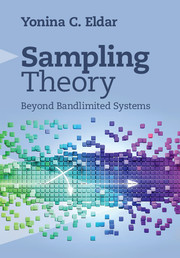Book contents
- Frontmatter
- Dedication
- Contents
- Preface
- 1 Introduction
- 2 Introduction to linear algebra
- 3 Fourier analysis
- 4 Signal spaces
- 5 Shift-invariant spaces
- 6 Subspace priors
- 7 Smoothness priors
- 8 Nonlinear sampling
- 9 Resampling
- 10 Union of subspaces
- 11 Compressed sensing
- 12 Sampling over finite unions
- 13 Sampling over shift-invariant unions
- 14 Multiband sampling
- 15 Finite rate of innovation sampling
- Appendix A Finite linear algebra
- Appendix B Stochastic signals
- References
- Index
15 - Finite rate of innovation sampling
Published online by Cambridge University Press: 05 August 2014
- Frontmatter
- Dedication
- Contents
- Preface
- 1 Introduction
- 2 Introduction to linear algebra
- 3 Fourier analysis
- 4 Signal spaces
- 5 Shift-invariant spaces
- 6 Subspace priors
- 7 Smoothness priors
- 8 Nonlinear sampling
- 9 Resampling
- 10 Union of subspaces
- 11 Compressed sensing
- 12 Sampling over finite unions
- 13 Sampling over shift-invariant unions
- 14 Multiband sampling
- 15 Finite rate of innovation sampling
- Appendix A Finite linear algebra
- Appendix B Stochastic signals
- References
- Index
Summary
In previous chapters we have seen that the UoS model can pave the way to sub-Nyquist sampling of certain categories of structured analog signals. In this chapter we consider an alternative model that relies on parametric representations: finite rate of innovation (FRI) signals [105]. This class corresponds to families of functions defined by a finite number of parameters per unit time, a quantity referred to as the rate of innovation. More specifically, a FRI signal x(t) is characterized by the fact that any finite duration segment of length r is completely determined by no more than k parameters. In this case, the function x(t) is said to have a local rate of innovation equal to k/r. The FRI viewpoint complements the UoS framework: a signal may lie in a UoS and have FRI; however, not all FRI signals can be described by a UoS model and vice versa, as we will show in examples below.
Interest in this class of signals emerges from the observation that several commonly encountered FRI signals can be perfectly recovered from samples taken at their rate of innovation. The advantage of this result is self-evident: FRI signals need not be bandlimited, and even if they are, the Nyquist frequency may be much higher than their rate of innovation. Thus, by using FRI techniques, the sampling rate required for perfect reconstruction can be reduced substantially. However, exploiting these capabilities requires careful design of the sampling mechanism and of the digital postprocessing.
- Type
- Chapter
- Information
- Sampling TheoryBeyond Bandlimited Systems, pp. 642 - 744Publisher: Cambridge University PressPrint publication year: 2015

